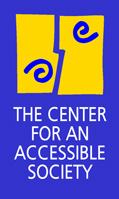
DISABILITY
ISSUES
INFORMATION
FOR
JOURNALISTS
TOPICS
ABOUT
THE CENTER
GUIDELINES ON HOW to make the Web accessible to people with disabilites were released May 5, 2000 by the World Wide Web Consortium (W3C), the international Web standards group. Development of the standards was supported in part by funding from the National Institute on Disability and Rehabilitation Research.
"The Web is such a critically important information resource that we have to make sure it does not shut people out," Judy Brewer, director of the Consortium's 18-month-old Web accessibility initiative told the New York Times's Cybertimes reporter Pamela Mendels.
The guidelines call for providing alternative text for images, ensuring that information is available to a person who cannot see images, and captions for audio files, to make information available to someone who cannot hear audio -- for whatever reason.
Accessible design benefits all Web users, said the W3C, because it allows "device-independence" for Web content.
Providing text descriptions for images help people accessing the Web from mobile phones, hand-held devices, or automobile-based PC's when connection speed is too slow to support viewing images or video. Captioning for audio files means audio information won't be lost to someone using the Web in noisy environments -- or in silent ones like libraries where sound is discouraged. The captions will also make it possible to index and search audio content.
"The W3C has provided a unique forum which has allowed us to bring together experts from industry, research and practice in a way that has not been possible before," said Greg Vanderheiden, Director of Trace Research & Development Center at the University of Wisconsin, Madison, and Co-Chair of the Web Content Guidelines Working Group. "The result is a set of guidelines that is more comprehensive, technically sound and practical than anything possible before. In addition, because the guidelines are built on the work and participation of virtually everyone who is active in this area, it provides us for the first time with a definitive set of guidelines that can serve as a reference for the field." The guidelines are the outcome of work done initially at the Trace Center's Info Tech Rehabilitation Engineering Research Center, funded by the National Institute on Disability and Rehabilitation Research.
"The Web Content Accessibility Guidelines explain what to do," said Tim Berners-Lee, Director of W3C. "It has always been difficult to know, when making a site more accessible, which changes are critical. These guidelines answer that question, and set common expectations so that providers of Web sites and users can be much more strategic. The bar has been set, and technologically it is not a very high bar. Some of the items in these guidelines will be unnecessary once authoring tools do them automatically. Now it is time to see which sites can live up to this."
The Web Content Accessibility Guidelines establish stable principles for accessible design, such as the need to provide equivalent alternatives for auditory and visual information. Each guideline has associated "checkpoints" explaining how these accessibility principles apply to specific features of sites. For example, providing alternative text for images ensures that information is available to a person who cannot see images. Providing captions for audio files makes information available to someone who cannot hear audio.
The guidelines are designed to be "forward-compatible" with evolving Web technologies, yet enable sites to "degrade gracefully" when confronted with older browsers.
Specifics on how to implement the checkpoints with the latest versions of mark-up or presentation languages such as HTML, CSS (Cascading Style Sheets), or SMIL (Synchronized Multimedia Integration Language) are described in a parallel "Techniques" document, to be updated periodically.
"Designing a More
Usable World for All," from the Trace Center
Fact Sheet for "Web Content Accessibility Guidelines 1.0"
Web Content Accessibility Guidelines
Web Content Accessibility Guideline Checkpoints
Overview.